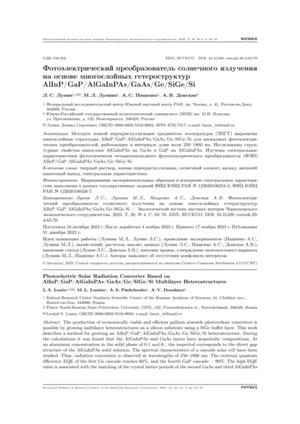Фотоэлектрический преобразователь солнечного излучения на основе многослойных гетероструктур AlInP/GaP/AlGaInPAs/GaAs/Ge/SiGe/Si
УДК
538.958EDN
RVUKUODOI:
10.31429/vestnik-20-4-63-70Аннотация
Методом зонной перекристаллизации градиентом температуры (ЗПГТ) выращены многослойные структуры AlInP/GaP/AlGaInPAs/GaAs/Ge/SiGe/Si для каскадных фотоэлектрических преобразователей, работающих в интервале длин волн 250–1800 нм. Исследованы структурные свойства нанослоев AlGaInPAs на GaAs и GaP на AlGaInPAs. Изучены спектральные характеристики фотоэлементов четырехкаскадного фотоэлектрического преобразователя (ФЭП) AlInP/GaP/AlGaInPAs/GaAs/Ge/SiGe/Si.
Ключевые слова:
твердый раствор, зонная перекристаллизация, солнечный элемент, каскад, внешний квантовый выход, спектральная характеристикаИнформация о финансировании
Выращивание экспериментальных образцов и измерение спектральных характеристик выполнены в рамках государственных заданий ФИЦ ЮНЦ РАН № 122020100254-3, ФИЦ ЮНЦ РАН № 122020100326-7.
Библиографические ссылки
- Aberle, A.G., Fabrication and characterization of crystalline silicon thin-film materials for solar cells. Thin Solid Films, 2006, vol. 511–512, pp. 26–34. DOI: 10.1016/j.tsf.2005.12.070
- Green, M.A., Polycrystalline silicon on glass for thin-film solar cell. Applied Physics A, 2009, vol. 96, no. 1, pp. 153–159. DOI: 10.1007/s00339-009-5090-9
- Косяченко, Л.А., Грушко, Е.В., Микитюк, Т.И., Поглощательная способность полупроводников, используемых в производстве солнечных панелей. Физика и техника полупроводников, 2012, т. 46, вып. 4, с. 482–486. [Kosyachenko L.A., Grushko E.V., Mikityuk T.I. Absorptivity of semiconductors used in the production of solar cell panels. Semiconductors, 2012, vol. 46, iss. 4, pp. 482–486. (in Russian)] DOI: 10.1134/S1063782612040124
- Колтун, М.М., Солнечные элементы. Москва, Наука, 1987. [Koltun M.M. Solnechnye elementy = Solar cells. Moscow, Nauka, 1987. (in Russian)]
- Андреев, В.М., Евстропов, В.В., Калиновский, В.С., Лантратов, В.М., Хвостиков, В.П., Токопрохождение и потенциальная эффективность (КПД) солнечных элементов на основе p-n-переходов из GaAs и GaSb. Физика и техника полупроводников, 2009, т. 43, № 5, с. 671–678. [Andreev V.M., Evstropov V.V., Kalinovsky V.S., Lantratov V.M., Khvostikov V.P. Current flow and potential efficiency of solar cells based on GaAs and GaSb p-n junctions. Semiconductors, 2009, vol. 43, no. 5, pp. 671–678. (in Russian)] DOI: 10.1134/S1063782609050200
- Seredin, P.V., Goloshchapov, D.L., Arsentyev, I.N., Nikolayev, D.N., Pikhtin, N.A., Slipchenko, S.O., Leiste, H., Prutskij, T. Structural-spectroscopic study of epitaxial GaAs layers grown on compliant substrates based on a superstructural layer and protoporous silicon. Applied Surface Science, 2021, vol. 537, pp. 147985. DOI: 10.1016/j.apsusc.2020.147985
- Nikhil, J., Mantu, K.H., III–V multijunction solar cell integration with silicon: Present status, challenges and future outlook. Energy Harvesting and Systems, 2014, vol. 1, iss. 3–4, pp. 121–145. DOI: 10.1515/ehs-2014-0012
- Alferov, Zh.I., Andreev, V.M., Rumyantsev, V.D., Solar photovoltaics: trends and prospects. Semiconductors, 2004, vol. 38, no. 8, pp. 899–908. DOI: 10.1134/1.1787110
- Скачков, А.Ф., Оптимизация структуры трёхпереходного солнечного элемента GaInP/GaAs/Ge со встроенным брэгговским отражателем Al0,1Ga0,9As/Al0,8Ga0,2As. Автометрия, 2014, т. 50, № 4, с. 122–126. [Skachkov A.F. Optimization of the structure of a GaInP/GaAs/Ge triple-junction solar cell with an Al0,1Ga0,9As/Al0,8Ga0,2As integrated bragg reflector. Avtometriya = Autometry, 2014, vol. 50, no. 4, pp. 122–126. (in Russian)] DOI: 10.3103/S8756699014040165
- Лозовский, В.Н. Лунин, Л.С. Попов, В.П., Зонная перекристаллизация градиентом температуры полупроводниковых материалов. Москва, Металлургия, 1987. [Lozovsky, V.N. Lunin, L.S. Popov, V.P., Zonnaya perekristallizaciya gradientom temperatury poluprovodnikovyh materialov = Zone recrystallization by temperature gradient of semiconductor materials. Moscow, Metallurgy, 1987. (in Russian)]
- Губенко, А.Я., Известия АН СССР. Неорганические материалы, 1990. т. 26. № 2. с. 413–417. [Gubenko, A.Ya., News of the AS USSR. Inorganic materials, 1990, vol. 26, no. 2, pp. 413–417. (in Russian)]
- Донская А.В., Расчёт периода кристаллической решётки полупроводниковых твёрдых растворов А3В5. Пат. 2022614299 Российская Федерация. 2022. [Donskaya, A.V., Raschyot perioda kristallicheskoj reshyotki poluprovodnikovyh tvyordyh rastvorov А3В5 = Calculation of the crystal lattice period of semiconductor solid solutions А3В5. Pat. 2022614299 Russian Federation, 2022. (in Russian)]
- Донская, А.В., Расчёт ширины запрещённой зоны полупроводниковых твёрдых растворов А3В5. Пат. 2022613673 Российская Федерация. 2022. [Donskaya, A.V., Raschyot shiriny zapreshchyonnoj zony poluprovodnikovyh tvyordyh rastvorov А3В5 = Calculation of the band gap of semiconductor solid solutions А3В5. Pat. 2022613673 Russian Federation, 2022. (in Russian)]
- Lu, X., Hao, R., Diaz, M., Opila, R.L., Barnett, A., Improving GaP solar cell performance by passivating the surface using AlxGa1–xP epi–layer. IEEE Journal of the Electron Devices Society, 2013, vol. 1, no. 5, pp. 111–116. DOI: 10.1109/JEDS.2013.2266410
Скачивания

Даты
Поступила в редакцию
Принята к публикации
Публикация
Как цитировать
Лицензия
Copyright (c) 2024 Лунин Л.С., Лунина М.Л., Пащенко А.С., Донская А.В.

Это произведение доступно по лицензии Creative Commons «Attribution» («Атрибуция») 4.0 Всемирная.


